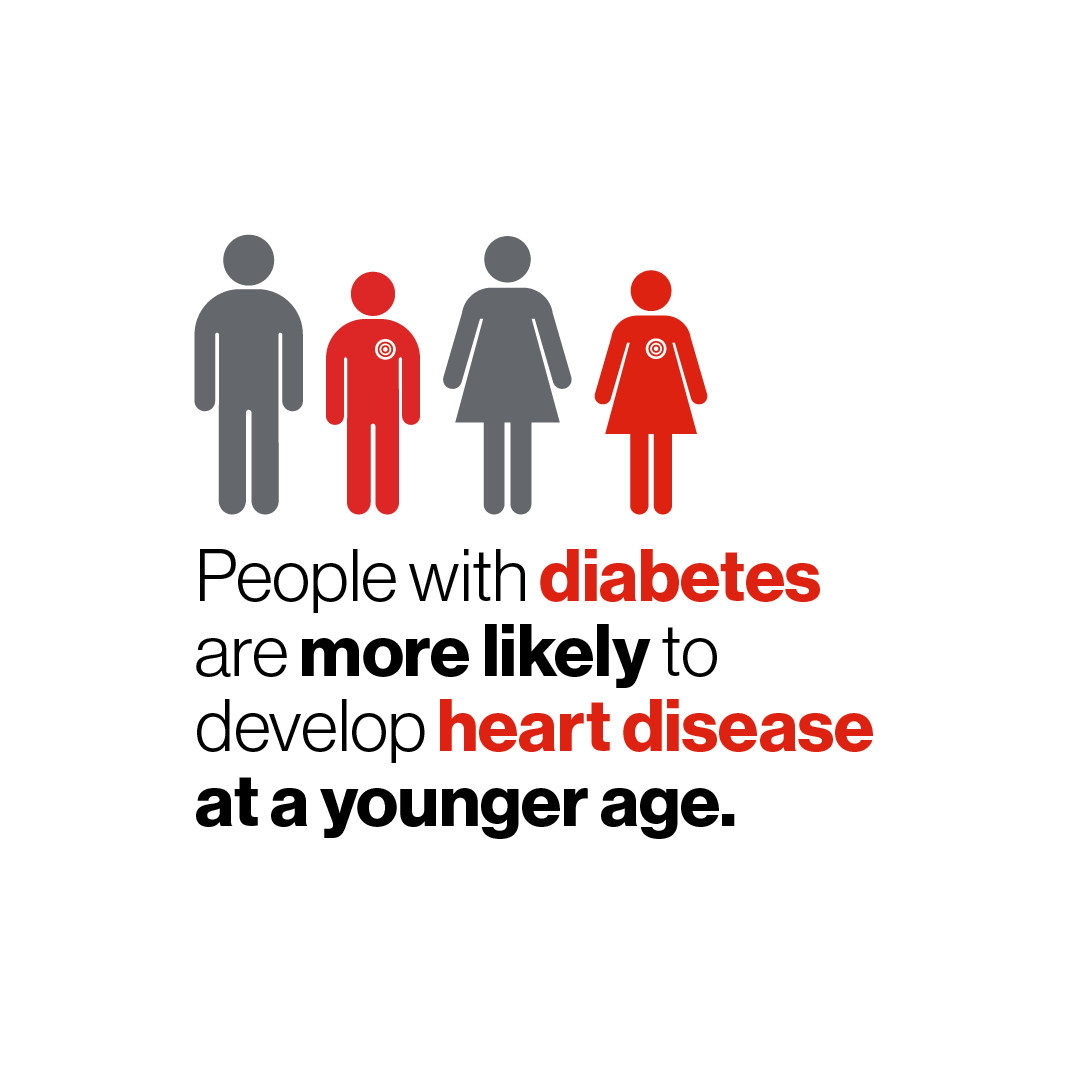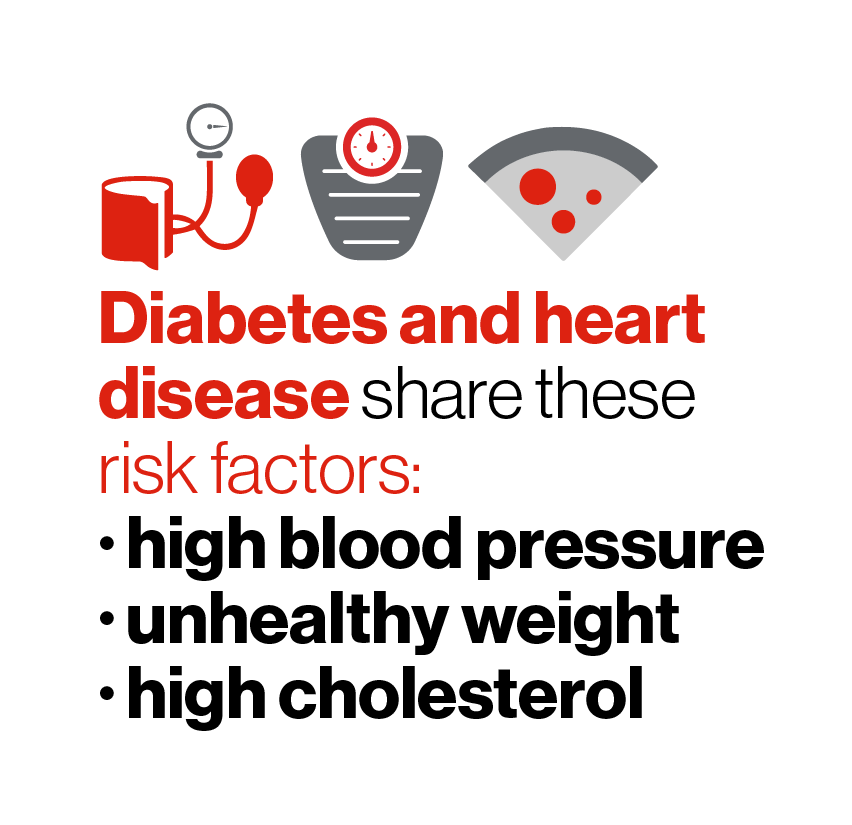Understanding blood sugar and your body
When you eat, your body breaks down food into glucose (sugar), which enters your bloodstream. This glucose is your body’s main source of energy, fueling your muscles, brain and other organs. To help move glucose from your blood into your cells, your pancreas releases a hormone called insulin.
In a healthy body, insulin keeps blood sugar levels in a normal range. But when your body doesn’t produce enough insulin—or can’t use it effectively—glucose (sugar) builds up in your blood. Over time, this can lead to prediabetes or diabetes and increase your risk of heart disease and stroke.
Why knowing your blood sugar numbers matter
Even if you feel fine, your blood sugar levels could be outside of the healthy range. That’s why it’s important to monitor them regularly—not just when symptoms appear.
Here’s why it matters:
- Spot silent risks: Blood sugar levels can be elevated without symptoms. Routine checks help uncover hidden risks.
- Catch issues early: Regular monitoring of your blood sugar levels helps identify changes before they become serious health problems.
- Protect your heart and brain: Knowing your blood sugar enables you to make informed decisions—like adjusting your eating habits or becoming more physically active.
- Track trends over time: Monitoring your numbers can reveal patterns that help you manage future risks.
- Empower proactive care: Even if your numbers are healthy, tracking them helps you stay ahead of potential changes.
- Follow screening guidelines:
- If you’re 40 or older, get tested every three to five years.
- If you have a family history of diabetes, talk to your healthcare provider or visit a pharmacy for a simple screening.
What is diabetes?
Diabetes is a chronic condition that occurs when blood sugar levels become too high due to problems with insulin. In type 1 diabetes, the body doesn’t produce enough insulin. In type 2 diabetes, the body can’t use insulin effectively—and may eventually produce less of it.
Without enough insulin to regulate blood sugar, glucose builds up in the bloodstream. Over time, high blood sugar can damage blood vessels, nerves and organs, increasing the risk of serious complications.
Heart disease, stroke and diabetes
Diabetes increases the risk of high blood pressure, narrowing of the arteries (atherosclerosis), coronary artery disease and stroke. So if you’re a person with diabetes, you have a higher risk of developing heart disease and stroke – and these conditions may also occur at a younger age for you.

Diabetes increases the risk of heart disease and stroke more significantly in women than in men, and women may face more severe outcomes.
Types of diabetes
- Prediabetes means your blood sugar levels are higher than normal, but not high enough to be classified as type 2 diabetes. It's a sign that your body may be starting to have trouble using insulin properly. If you have prediabetes, your risk of heart disease, stroke and other conditions related to diabetes may increase.
If you’ve been told you have prediabetes, you can lower your risk of developing type 2 diabetes by making healthy changes to your daily routine—like choosing nutritious foods and being more active.
- Type 2 diabetes is the most common type of diabetes, accounting for 90 to 95% of all diabetes cases in Canada. While it typically develops in adults, children can be affected as well. It occurs when the body doesn’t produce enough insulin or can’t use it effectively. Over time, the pancreas may also produce less insulin, making it harder to manage blood sugar levels.
Although factors like genetics and environment can play a role, lifestyle choices such as healthy eating and regular physical activity can help manage or even delay the onset of type 2 diabetes.
A note on insulin resistance:
This happens when your body makes insulin but doesn’t use it properly, causing blood sugar to build up. In response, the pancreas tries to keep up by producing more insulin, but over time, it can’t meet the demand—leading to rising blood sugar levels. This can eventually lead to prediabetes, type 2 diabetes, and a higher risk of heart disease and stroke.
- Type 1 diabetes usually begins in childhood, but it can also develop in adults. It happens when the body’s immune system attacks the pancreas and destroys beta cells, which make insulin. These beta cells also release a hormone called amylin, which helps control how quickly glucose enters your bloodstream. Once these cells are destroyed, the pancreas can no longer make enough insulin, causing sugar to build up in the blood.
Only about 5-10% of people with diabetes have type 1. The exact cause of type 1 diabetes isn’t fully known, but it’s likely due to a combination of genetic predisposition and environmental factors. If someone in your family has type 1 diabetes, your risk of getting it is higher.
- Gestational diabetes is a temporary condition where your body can’t properly use insulin during pregnancy. During pregnancy, the placenta produces hormones that can make your cells more resistant to insulin. Usually, your pancreas produces extra insulin to overcome this, but sometimes it can’t keep up, which causes gestational diabetes.
Having gestational diabetes increases the risk of the mother and child developing diabetes later in life. It can also increase the mother’s risk of heart disease and stroke—especially if it occurs during multiple pregnancies.


Who is at risk?
If you have a family history of diabetes, it’s important to get tested—even if you don’t have symptoms—since your risk for both type 1 and type 2 diabetes is higher. And if you’ve already been diagnosed, encourage your family members to get tested too. Early detection can help prevent complications and support better long-term health.

Risk factors for type 1
The exact cause of type 1 diabetes remains unknown. But having a family member with type 1 diabetes increases your risk of developing it.
Risk factors for type 2
There are several risk factors for type 2 diabetes. Many of these are also risk factors for heart disease, stroke and other chronic conditions. They include:
- Family history —having a family member with type 2 diabetes increases your risk.
- Weight—your risk could increase if you are overweight or you carry a lot of weight around your stomach.
- Ethnicity—African, Asian and Hispanic peoples are at a higher risk of developing diabetes.
- Low-income — living on a low income or having limited access to affordable, healthy food may increase your risk of developing type 2 diabetes.
- High-blood pressure
- High cholesterol
- Gestational diabetes — About 30-40% of women who have had gestational diabetes will develop type 2 diabetes within 15 years.
- Prediabetes — having prediabetes is a major risk factor for developing type 2 diabetes.
- Medical conditions —the following conditions can increase your risk for type 2 diabetes:
- polycystic ovary syndrome
- psychiatric disorders (depression, bipolar disorder, schizophrenia)
- obstructive sleep apnea
- Indigenous populations – due to social, systemic and institutional barriers, Indigenous people are at a higher risk for diabetes.
Symptoms
Symptoms for type 1 diabetes usually develop suddenly and quickly. Type 2 symptoms develop more slowly and may be invisible.
Signs and symptoms of diabetes could include:
- unusual thirst
- frequent urination
- weight change (gain or loss)
- extreme fatigue or lack of energy
- blurred vision
- frequent or recurring infections
- cuts and bruises that are slow to heal
- tingling or numbness in the hands or feet
- trouble getting or maintaining an erection
Diagnosis
To diagnose diabetes, your doctor will review your symptoms, go over your medical history and complete a physical exam.
Tests will be done to measure glucose levels in your blood. Some examples include:
- A1C test
- fasting blood glucose
- random blood glucose
- oral glucose tolerance
A second test is usually needed to confirm a diabetes diagnosis, unless you’re showing clear signs and symptoms.
Monitoring
For people with diabetes, daily tools and support are essential for effective monitoring and medication management. These may include blood glucose meters, continuous glucose monitors (CGMs), or flash glucose monitors (FGMs), along with insulin or other prescribed medications. These tools help manage blood sugar levels and reduce the risk of complications.
Screening (for healthy adults)
Even if you don’t have diabetes and think you are healthy, checking your blood sugar can offer valuable insights into your overall health. Simple options like a pinprick test at a pharmacy or routine blood work through your healthcare provider are accessible ways to know your numbers. While tests such as A1C or oral glucose tolerance tests (OGTT) are typically used when a problem is suspected or during pregnancy screening, routine screening is recommended every three to five years for adults aged 40 and older—or earlier if you have risk factors or a family history of diabetes.
Treatment
Managing your diabetes is important to prevent heart disease and stroke. Treatment for diabetes may include medication and lifestyle changes. You and your doctor will discuss the treatment options and decide which is best for you.
Controlling blood sugar through healthy lifestyle choices
- Controlling your blood sugar level is crucial to your health (and your baby’s health if you have gestational diabetes). Healthy lifestyle choices can help bring your blood sugar level back to normal or keep it from rising. The good news is that the lifestyle changes you need to make are the same choices that will help you to lower your risk of heart disease, stroke and other medical conditions. Find more information on how to get healthy.
Controlling blood sugar with medication
- There are several oral medications to treat type 2 diabetes that work in different ways to control blood sugar by increasing insulin production, making you more sensitive to insulin or slowing digestion. You might also need medications to control your cholesterol and high blood pressure. Learn more about medications that can protect you from heart disease and stroke.
Insulin
- Insulin therapy is required for the treatment of type 1 diabetes. Your doctor will help you to understand the dosage, timing and number of injections you might need.
- People living with type 2 diabetes may also need insulin. The key to managing type 2 diabetes is monitoring and maintaining your blood sugar levels in the target range set by you and your healthcare provider.
Living with diabetes
Here are the ABCDESSS of living with diabetes. Follow these basic steps to protect your health:
A: A1C. Monitor and control your blood sugar levels regularly. A1C tests show your average over 2-3 months, while daily tools–like glucose meters, CGMs, FGMs or insulin pumps–help you stay in a healthy range and respond to changes in real time.
B: Blood pressure. Know your blood pressure and take steps to keep it in a healthy range.
C: Cholesterol. Make sure your LDL cholesterol levels are low.
D: Drugs to decrease heart disease risk. This might include blood pressure pills, cholesterol-lowering pills and others.
E: Exercise and healthy eating.
S: Self-management support. Set goals to reach and maintain a healthy lifestyle and understand what stands in your way.
S: Screening or monitoring for complications. Be sure to check in with your doctor about the health of your heart, feet, kidneys, and eyes.
S: Stop smoking.
Related information
- Learn about the risk factors for heart disease and stroke.
- Visit Diabetes Canada for more information about diabetes and cardiovascular protection in people with diabetes.
- Use HeartHub’s research guide to learn more about the treatment options for coronary artery disease and diabetes.
